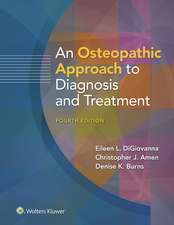Fundamentals of Pain Medicine: How to Diagnose and Treat your Patients
Autor Dr. J.D. Hoppenfeld MDen Limba Engleză Hardback – 13 iun 2014
Diagnose and treat your patients confidently with Fundamentals of Pain Medicine. This comprehensive new resource addresses the concerns you face when treating your patients with acute and chronic pain. Chapters present the key pain management options available today along with expert advice and insight into overcoming diagnostic and therapeutic obstacles, including prescribing medications and avoiding opioid abuse. In addition to interventional and non-interventional treatments, multidisciplinary approaches such as physical therapy, complementary therapy, and chiropractic treatment are presented.
Fundamentals of Pain Medicine is an essential guide for any healthcare professional seeking to improve the quality of pain treatments and patients’ comfort.
Features:
Fundamentals of Pain Medicine is an essential guide for any healthcare professional seeking to improve the quality of pain treatments and patients’ comfort.
Features:
- eBook with searchable text, accessible image bank, and patient education materials
- Illustrations accompanying text with numerous images and boxed elements
- Numerous case examples and most common treatments, relevant and applicable to everyday clinical use
- Step-by-step instruction on office-based procedures
- Complete content with enhanced navigation
- A powerful search that pulls results from content in the book, your notes, and even the web
- Cross-linked pages, references, and more for easy navigation
- Highlighting tool for easier reference of key content throughout the text
- Ability to take and share notes with friends and colleagues
- Quick reference tabbing to save your favorite content for future
Preț: 618.36 lei
Preț vechi: 759.80 lei
-19% Nou
Puncte Express: 928
Preț estimativ în valută:
118.34€ • 123.09$ • 97.69£
118.34€ • 123.09$ • 97.69£
Carte disponibilă
Livrare economică 28 martie-09 aprilie
Preluare comenzi: 021 569.72.76
Specificații
ISBN-13: 9781451144499
ISBN-10: 1451144490
Pagini: 288
Ilustrații: 477
Dimensiuni: 213 x 276 x 20 mm
Greutate: 0.98 kg
Editura: LWW
Colecția Lww
ISBN-10: 1451144490
Pagini: 288
Ilustrații: 477
Dimensiuni: 213 x 276 x 20 mm
Greutate: 0.98 kg
Editura: LWW
Colecția Lww
Cuprins
Introduction"
Part I: Symptoms and Conditions
1. Musculoskeletal Pain: Common Causes
· Pain in the Shoulder
- Bursitis
- Arthritis (Glenohumeral and Acromioclavicular)
- Rotator Cuff Injury
- Adhesive Capsulitis
· Pain in the Elbow
- Tendinitis
o Tennis Elbow (Lateral Epicondylitis)
o Golfer’s Elbow (Medial Epicondylitis)
- Olecranon Bursitis
- Traumatic Arthritis
· Pain in the Neck (Cervical Spine)
· Pain in the Low Back (Lumbar Spine)
- Muscles and Ligaments
- Vertebral Bodies
- Facet Joints
- Vertebral Disc
· Pain in the Hip
- Arthritis
- Ischemic (Avascular) Necrosis of the Hip
- Fractures
· Pain in the Buttock
- The Sacroiliac Joint (SI joint)
- Greater Trochanteric Bursitis
- Ischiogluteal Bursitis
· Pain in the Knees
- Osteoarthritis of the Knee Joint
- Meniscal Tear
- Patellofemoral Arthritis
- Patellar Tendonitis
- Osteochondritis
· Case Studies
2. Neuropathic pain
· In the Face: Trigeminal Neuralgia
· In the Thumb, Index, and Middle Finger: Carpal Tunnel Syndrome
· In the Thoracic Region: Postherpetic Neuralgia
· In the Back or Neck and Down the Leg or Arm: Radicular Pain
· Down the Legs or Arms: Spinal Canal Stenosis
· On the Top and Lateral Aspect of the Mid-Thigh: Lateral Femoral Cutaneous Neuropathy (Meralgia Paresthetica)
· In the Feet or Hands: Peripheral Neuropathy
· In a Stump and Phantom Limb Pain
· Postsurgical Neuropathic Pain Syndromes:
- Post-Thoracotomy Pain Syndrome
· Postsurgical Pelvic Nerve Entrapment: The Iliohypogastric Nerve, Ilioinguinal Nerve, and Genitofemoral Nerve
· Case Studies
3. Cancer Pain
· History and Exam
- Metastatic Bone Pain
- Visceral Pain
- Neuropathic Pain Related to Cancer
- Intracranial Primary or Metastatic Tumor Pain, Headache
- Spinal Cord Compression
- Pain caused by surgery for cancer
- Preexisting painful conditions
· Treatment
· Case Study
4. Abdominal Pain
· Visceral Abdominal Pain
· Somatic Abdominal Pain
· Referred pain
· History and Exam
· Treatment
· Case Studies
5. Pelvic Pain
· History and Exam
- Visceral Pelvic Pain
- Somatic Pelvic Pain
- Neuropathic Pelvic Pain
· Treatment
- Medications
- Injections
- Surgery
· Case Study
6. Podiatric Pain, Foot and Ankle
· Plantar fasciitis
· Hallux valgus (bunion)
· Morton’s neuroma
· Tarsal tunnel syndrome
· Diabetic peripheral neuropathy
· History and Exam
· Treatment
· Case Studies
7. Miscellaneous Pain Disorders that Affect Multiple Areas of the Body: Complex Regional Pain Syndrome (CRPS, formerly known as Reflex Sympathetic Dystrophy), Fibromyalgia, and Sickle Cell Pain
· Complex Regional Pain Syndrome (CRPS, Formerly Known as Reflex Sympathetic Dystrophy)
- History and Exam
- Treatment
- Case Study
· Fibromyalgia
- History and Exam
- Treatment
- Case Study
· Sickle Cell Pain
- History and Exam
- Treatment
- Case Study
8. Postoperative Pain Management
· History and Exam
· Treatment
· Case Studies
Part II: Noninterventional Treatments
9. Nonsteroidal Anti-Inflammatory Drugs (NSAIDs)
· When to Use
· How to Use
· When Not to Use and Potential Side Effects
· Case Study
10. Acetaminophen (Tylenol)
· When to Use
· How to Use
· When Not to Use and Potential Side Effects
· Case Study
11. Topical Pain Medications
· When to Use
· How to Use
· When Not to Use and Potential Side Effects
· Case Study
12. Muscle Relaxants
· When to Use
· How to Use
· When Not to Use and Potential Side Effects
· Case Study
13. Antidepressant Medications Used for Neuropathic Pain
· When to Use
· How to Use
· When Not to Use and Potential Side Effects
· Case Study
14. Antiseizure Medications Used for Neuropathic Pain
· When to Use
· How to Use
· When Not to Use and Potential Complications
· Case Study
15. Opioids
· When to Use
· How to Use
- Hospital setting: Intravenous Opioids
- Hospital or outpatient setting: Short-acting oral narcotics
- Outpatient setting, chronic pain: Long-acting oral narcotics
- Long-Acting (Time-Release) Opioid Medication Choices
- Breakthrough Pain Management
- Other Narcotic-Like Pain Medication
· When Not to Use and Potential Complications
· Case Study
16. The Patient Controlled Analgesia Device (PCA)
· When to Use
· How to Use
· When Not to Use and Potential Complications
· Case Study
17. Epidural Catheter Analgesia
· When to Use
- Surgical Setting
- Childbirth Setting
· How to Use
- Surgical Setting
- Childbirth Setting
· When Not to Use and Potential Complications
· Case Studies
18. Radiation Therapy
· When to Use
- Pain from a Solid Tumor
- Metastatic Bone Pain
- Cord Compression
· How to Use
· When Not to Use and Potential Complications
· Case Study
Part III: Interventional Treatments:
19. Epidural Steroid Injections
· When to Use
· How the Procedure is Done
- Intralaminar Epidural Steroid Injection
- Transforaminal Lumbar Epidural Steroid Injection
- Reasons for a nontherapeutic response to an epidural steroid injection and modes of correction
· When Not to Use and Potential Complications
· Case Study
20. Facet Joint Procedures: Facet Joint Injections, Medial Branch Nerve Blocks, and Radiofrequency Ablation of the Medial Branch Nerves
· Diagnostic Injection vs. Diagnostic Therapeutic Injection
· Facet Joint injections vs. Medial Branch Nerve Block
· When to Use
· How the Procedure is Done
- Facet Joint Injections (diagnostic and therapeutic injection)
- Medial Branch Nerve Blocks
- Radiofrequency Ablation of the Medial Branch Nerve
· When Not to Use and Potential Complications
· Case Studies
21. Sacroiliac Joint Injections
· When to Use
· How the Procedure is Done
- Diagnostic SI Joint Injections
- Therapeutic SI Joint Injection
- SI Joint Radiofrequency
· When Not to Use and Potential Complications
· Case Study
22. Trigger Point Injections for Myofascial Pain
· When to Use
· How the Procedure is Done
· When Not to Use and Potential Complications
· Case Study
23. Joint and Associated Bursa Injections: Shoulders, Elbow, Hip and Knees
· When to Use
· How the Procedure is Done
- Shoulder region
o Shoulder (glenohumeral) joint injection
o Shoulder (acromiclavicular) joint injection
o Shoulder (subacromial bursa) injection
- Elbow
o Lateral epicondyle (tennis elbow) injection
o Medial epicondyle (golfer’s elbow) injection
o Elbow Joint Injection
o Olecranon bursa injection
- Hip
o Intra-articular hip injection
o Greater trochanteric bursa injection
- Knee
o Intra-articular knee joint injection (cortisone and viscosupplementation)
· When Not to Use and Potential Complications
· Case Studies
24. Sympathetic Blocks: Stellate, Celiac, Lumbar, Superior Hypogastric and Ganglion Impar
· When to Use
· How the Procedure is Done
- Stellate Ganglion Block
- Celiac Plexus Block
- Neurolytic Celiac Plexus Block for Cancer Pain
- Lumbar Sympathetic Block (Paravertebral block)
- Superior Hypogastric Block (Ganglion of Walther)
- Neurolytic Superior Hypogastric Block for Cancer Pain
- Ganglion Impar Block
- Neurolytic Ganglion Impar Block for Cancer Pain
· When Not to Use and Potential Complications
· Case Studies
25. Vertebroplasty and Kyphoplasty
· When to Use
· How the Procedures Are Done
· When Not to Use and Potential Complications
· Case Study
26. Injections for Headache (Occipital Nerve Blocks and Botulinum Toxin Injections)
· Occipital Nerve Block
· Botulinum Toxin Injection
· When to Use
· How the Procedures are Done
- Occipital Nerve Block
- Botulinum Toxin Injections for Headache
· When Not to Use and Potential Complications
· Case Studies
27. Common Nerve Blocks
· When to Use
· How the Procedure Is Done
- Trigeminal Nerve Block (Trigeminal Neuralgia)
- Median Nerve Block (Carpal Tunnel Syndrome)
- Suprascapular Nerve Block (Frozen Shoulder)
- Intercostal Nerve Block
- Pelvic Nerve Block (Iliohypogastric, Ilioinguinal and Genitofemoral)
- Lateral Femoral Cutaneous Nerve Block (Meralgia Paresthetica)
- Tibial Nerve Block (Tarsal Tunnel Syndrome)
· When Not to Use and Potential Complications
· Case Studies
28. Discogenic Pain: Lumbar Discography
· Introduction
· When to Use
· How the Procedure is Done
· When Not to Use and Potential Complications
· Case Study
29. Implantable Pain Devices: Spinal Cord Stimulators
· When to Use
· How the Procedure is Done
- Trial—Lower Body Pain
- Trial—Upper Body Pain
- Full Implant
· When Not to Use and Potential Complications
· Case Study
30. Implantable Pain Device: Programmable Intrathecal Pain Pumps
· When to Use
· How the Procedures Are Done
- The Trial
- Full Implementation
- Pump Refills
· When Not to Use and Potential Complications
· Case Study
31. Percutaneous Lumbar Disc Decompression
· When to Use
· How the Procedure is Done
· When Not to Use and Potential Complications
· Case Study
Part IV: Multimodal Approach to Pain
32. Physical Therapy
· When to Use
· How to Use
- Balance
- Building Endurance
- Stretching/Range of Motion
- Strengthening
- Other Modalities: Heat, Ultrasound, Transcutaneous Electrical Nerve Stimulation (TENS)
· When Not to Use
· Case Studies
33. Complementary Treatments
· Acupuncture
· Cognitive Behavioral Therapy (CBT)
· Biofeedback
· Therapeutic Massage
· Hypnosis
· Case Study
34. Chiropractic Treatment
· When to Use
· How to Use
· When Not to Use
· Case Study
35. Avoiding Opioid Abuse
· Curtailing Abuse and Diversion
- Determine if the patient needs an opioid
- Realistic expectations, prescribing opioids, and the narcotic agreement
- Monitoring patients on opioids: structured follow-up appointments, assessing function, urine drug screens, and prescription monitoring programs
· Handling Abuse and Diversion Once Discovered
- Addressing violations of the narcotic agreement
- Discharging patients from the practice
Part I: Symptoms and Conditions
1. Musculoskeletal Pain: Common Causes
· Pain in the Shoulder
- Bursitis
- Arthritis (Glenohumeral and Acromioclavicular)
- Rotator Cuff Injury
- Adhesive Capsulitis
· Pain in the Elbow
- Tendinitis
o Tennis Elbow (Lateral Epicondylitis)
o Golfer’s Elbow (Medial Epicondylitis)
- Olecranon Bursitis
- Traumatic Arthritis
· Pain in the Neck (Cervical Spine)
· Pain in the Low Back (Lumbar Spine)
- Muscles and Ligaments
- Vertebral Bodies
- Facet Joints
- Vertebral Disc
· Pain in the Hip
- Arthritis
- Ischemic (Avascular) Necrosis of the Hip
- Fractures
· Pain in the Buttock
- The Sacroiliac Joint (SI joint)
- Greater Trochanteric Bursitis
- Ischiogluteal Bursitis
· Pain in the Knees
- Osteoarthritis of the Knee Joint
- Meniscal Tear
- Patellofemoral Arthritis
- Patellar Tendonitis
- Osteochondritis
· Case Studies
2. Neuropathic pain
· In the Face: Trigeminal Neuralgia
· In the Thumb, Index, and Middle Finger: Carpal Tunnel Syndrome
· In the Thoracic Region: Postherpetic Neuralgia
· In the Back or Neck and Down the Leg or Arm: Radicular Pain
· Down the Legs or Arms: Spinal Canal Stenosis
· On the Top and Lateral Aspect of the Mid-Thigh: Lateral Femoral Cutaneous Neuropathy (Meralgia Paresthetica)
· In the Feet or Hands: Peripheral Neuropathy
· In a Stump and Phantom Limb Pain
· Postsurgical Neuropathic Pain Syndromes:
- Post-Thoracotomy Pain Syndrome
· Postsurgical Pelvic Nerve Entrapment: The Iliohypogastric Nerve, Ilioinguinal Nerve, and Genitofemoral Nerve
· Case Studies
3. Cancer Pain
· History and Exam
- Metastatic Bone Pain
- Visceral Pain
- Neuropathic Pain Related to Cancer
- Intracranial Primary or Metastatic Tumor Pain, Headache
- Spinal Cord Compression
- Pain caused by surgery for cancer
- Preexisting painful conditions
· Treatment
· Case Study
4. Abdominal Pain
· Visceral Abdominal Pain
· Somatic Abdominal Pain
· Referred pain
· History and Exam
· Treatment
· Case Studies
5. Pelvic Pain
· History and Exam
- Visceral Pelvic Pain
- Somatic Pelvic Pain
- Neuropathic Pelvic Pain
· Treatment
- Medications
- Injections
- Surgery
· Case Study
6. Podiatric Pain, Foot and Ankle
· Plantar fasciitis
· Hallux valgus (bunion)
· Morton’s neuroma
· Tarsal tunnel syndrome
· Diabetic peripheral neuropathy
· History and Exam
· Treatment
· Case Studies
7. Miscellaneous Pain Disorders that Affect Multiple Areas of the Body: Complex Regional Pain Syndrome (CRPS, formerly known as Reflex Sympathetic Dystrophy), Fibromyalgia, and Sickle Cell Pain
· Complex Regional Pain Syndrome (CRPS, Formerly Known as Reflex Sympathetic Dystrophy)
- History and Exam
- Treatment
- Case Study
· Fibromyalgia
- History and Exam
- Treatment
- Case Study
· Sickle Cell Pain
- History and Exam
- Treatment
- Case Study
8. Postoperative Pain Management
· History and Exam
· Treatment
· Case Studies
Part II: Noninterventional Treatments
9. Nonsteroidal Anti-Inflammatory Drugs (NSAIDs)
· When to Use
· How to Use
· When Not to Use and Potential Side Effects
· Case Study
10. Acetaminophen (Tylenol)
· When to Use
· How to Use
· When Not to Use and Potential Side Effects
· Case Study
11. Topical Pain Medications
· When to Use
· How to Use
· When Not to Use and Potential Side Effects
· Case Study
12. Muscle Relaxants
· When to Use
· How to Use
· When Not to Use and Potential Side Effects
· Case Study
13. Antidepressant Medications Used for Neuropathic Pain
· When to Use
· How to Use
· When Not to Use and Potential Side Effects
· Case Study
14. Antiseizure Medications Used for Neuropathic Pain
· When to Use
· How to Use
· When Not to Use and Potential Complications
· Case Study
15. Opioids
· When to Use
· How to Use
- Hospital setting: Intravenous Opioids
- Hospital or outpatient setting: Short-acting oral narcotics
- Outpatient setting, chronic pain: Long-acting oral narcotics
- Long-Acting (Time-Release) Opioid Medication Choices
- Breakthrough Pain Management
- Other Narcotic-Like Pain Medication
· When Not to Use and Potential Complications
· Case Study
16. The Patient Controlled Analgesia Device (PCA)
· When to Use
· How to Use
· When Not to Use and Potential Complications
· Case Study
17. Epidural Catheter Analgesia
· When to Use
- Surgical Setting
- Childbirth Setting
· How to Use
- Surgical Setting
- Childbirth Setting
· When Not to Use and Potential Complications
· Case Studies
18. Radiation Therapy
· When to Use
- Pain from a Solid Tumor
- Metastatic Bone Pain
- Cord Compression
· How to Use
· When Not to Use and Potential Complications
· Case Study
Part III: Interventional Treatments:
19. Epidural Steroid Injections
· When to Use
· How the Procedure is Done
- Intralaminar Epidural Steroid Injection
- Transforaminal Lumbar Epidural Steroid Injection
- Reasons for a nontherapeutic response to an epidural steroid injection and modes of correction
· When Not to Use and Potential Complications
· Case Study
20. Facet Joint Procedures: Facet Joint Injections, Medial Branch Nerve Blocks, and Radiofrequency Ablation of the Medial Branch Nerves
· Diagnostic Injection vs. Diagnostic Therapeutic Injection
· Facet Joint injections vs. Medial Branch Nerve Block
· When to Use
· How the Procedure is Done
- Facet Joint Injections (diagnostic and therapeutic injection)
- Medial Branch Nerve Blocks
- Radiofrequency Ablation of the Medial Branch Nerve
· When Not to Use and Potential Complications
· Case Studies
21. Sacroiliac Joint Injections
· When to Use
· How the Procedure is Done
- Diagnostic SI Joint Injections
- Therapeutic SI Joint Injection
- SI Joint Radiofrequency
· When Not to Use and Potential Complications
· Case Study
22. Trigger Point Injections for Myofascial Pain
· When to Use
· How the Procedure is Done
· When Not to Use and Potential Complications
· Case Study
23. Joint and Associated Bursa Injections: Shoulders, Elbow, Hip and Knees
· When to Use
· How the Procedure is Done
- Shoulder region
o Shoulder (glenohumeral) joint injection
o Shoulder (acromiclavicular) joint injection
o Shoulder (subacromial bursa) injection
- Elbow
o Lateral epicondyle (tennis elbow) injection
o Medial epicondyle (golfer’s elbow) injection
o Elbow Joint Injection
o Olecranon bursa injection
- Hip
o Intra-articular hip injection
o Greater trochanteric bursa injection
- Knee
o Intra-articular knee joint injection (cortisone and viscosupplementation)
· When Not to Use and Potential Complications
· Case Studies
24. Sympathetic Blocks: Stellate, Celiac, Lumbar, Superior Hypogastric and Ganglion Impar
· When to Use
· How the Procedure is Done
- Stellate Ganglion Block
- Celiac Plexus Block
- Neurolytic Celiac Plexus Block for Cancer Pain
- Lumbar Sympathetic Block (Paravertebral block)
- Superior Hypogastric Block (Ganglion of Walther)
- Neurolytic Superior Hypogastric Block for Cancer Pain
- Ganglion Impar Block
- Neurolytic Ganglion Impar Block for Cancer Pain
· When Not to Use and Potential Complications
· Case Studies
25. Vertebroplasty and Kyphoplasty
· When to Use
· How the Procedures Are Done
· When Not to Use and Potential Complications
· Case Study
26. Injections for Headache (Occipital Nerve Blocks and Botulinum Toxin Injections)
· Occipital Nerve Block
· Botulinum Toxin Injection
· When to Use
· How the Procedures are Done
- Occipital Nerve Block
- Botulinum Toxin Injections for Headache
· When Not to Use and Potential Complications
· Case Studies
27. Common Nerve Blocks
· When to Use
· How the Procedure Is Done
- Trigeminal Nerve Block (Trigeminal Neuralgia)
- Median Nerve Block (Carpal Tunnel Syndrome)
- Suprascapular Nerve Block (Frozen Shoulder)
- Intercostal Nerve Block
- Pelvic Nerve Block (Iliohypogastric, Ilioinguinal and Genitofemoral)
- Lateral Femoral Cutaneous Nerve Block (Meralgia Paresthetica)
- Tibial Nerve Block (Tarsal Tunnel Syndrome)
· When Not to Use and Potential Complications
· Case Studies
28. Discogenic Pain: Lumbar Discography
· Introduction
· When to Use
· How the Procedure is Done
· When Not to Use and Potential Complications
· Case Study
29. Implantable Pain Devices: Spinal Cord Stimulators
· When to Use
· How the Procedure is Done
- Trial—Lower Body Pain
- Trial—Upper Body Pain
- Full Implant
· When Not to Use and Potential Complications
· Case Study
30. Implantable Pain Device: Programmable Intrathecal Pain Pumps
· When to Use
· How the Procedures Are Done
- The Trial
- Full Implementation
- Pump Refills
· When Not to Use and Potential Complications
· Case Study
31. Percutaneous Lumbar Disc Decompression
· When to Use
· How the Procedure is Done
· When Not to Use and Potential Complications
· Case Study
Part IV: Multimodal Approach to Pain
32. Physical Therapy
· When to Use
· How to Use
- Balance
- Building Endurance
- Stretching/Range of Motion
- Strengthening
- Other Modalities: Heat, Ultrasound, Transcutaneous Electrical Nerve Stimulation (TENS)
· When Not to Use
· Case Studies
33. Complementary Treatments
· Acupuncture
· Cognitive Behavioral Therapy (CBT)
· Biofeedback
· Therapeutic Massage
· Hypnosis
· Case Study
34. Chiropractic Treatment
· When to Use
· How to Use
· When Not to Use
· Case Study
35. Avoiding Opioid Abuse
· Curtailing Abuse and Diversion
- Determine if the patient needs an opioid
- Realistic expectations, prescribing opioids, and the narcotic agreement
- Monitoring patients on opioids: structured follow-up appointments, assessing function, urine drug screens, and prescription monitoring programs
· Handling Abuse and Diversion Once Discovered
- Addressing violations of the narcotic agreement
- Discharging patients from the practice
Descriere
Diagnose and treat your patients confidently with Fundamentals of Pain Medicine. This comprehensive new resource addresses the concerns you face when treating your patients with acute and chronic pain. Chapters present the key pain management options available today along with expert advice and insight into overcoming diagnostic and therapeutic obstacles, including prescribing medications and avoiding opioid abuse. In addition to interventional and non-interventional treatments, multidisciplinary approaches such as physical therapy, complementary therapy, and chiropractic treatment are presented.
Fundamentals of Pain Medicine is an essential guide for any healthcare professional seeking to improve the quality of pain treatments and patients’ comfort.
Features:
Fundamentals of Pain Medicine is an essential guide for any healthcare professional seeking to improve the quality of pain treatments and patients’ comfort.
Features:
- eBook with searchable text, accessible image bank, and patient education materials
- Illustrations accompanying text with numerous images and boxed elements
- Numerous case examples and most common treatments, relevant and applicable to everyday clinical use
- Step-by-step instruction on office-based procedures
- Complete content with enhanced navigation
- A powerful search that pulls results from content in the book, your notes, and even the web
- Cross-linked pages, references, and more for easy navigation
- Highlighting tool for easier reference of key content throughout the text
- Ability to take and share notes with friends and colleagues
- Quick reference tabbing to save your favorite content for future






